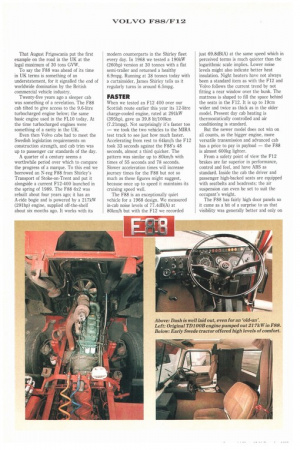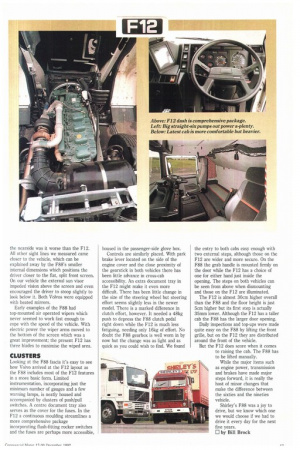That August Frigoscania put the first example on the road
Page 44

Page 45

If you've noticed an error in this article please click here to report it so we can fix it.
in the UK at the legal maximum of 30 tons GVW.
To say the F88 was ahead of its time in UK terms is something of an understatement, for it signalled the end of worldwide domination by the British commercial vehicle industry.
Twenty-five years ago a sleeper cab was something of a revelation, The F88 cab tilted to give access to the 9,6-litre turbocharged engine below; the same basic engine used in the FL10 today. At the time turbocharged engines were something of a rarity in the UK.
Even then Volvo cabs had to meet the Swedish legislation requirements on construction strength, and cab trim was up to passenger car standards of the day.
A quarter of a century seems a worthwhile period over which to compare the progress of a marque. To this end we borrowed an N-reg F88 from Shirley's Transport of Stoke-on-Trent and put it alongside a current F12-400 launched in the spring of 1989. The F88 6x2 was rebuilt about four years ago; it has an A-ride bogie and is powered by a 217kW (291hp) engine, supplied off-the-shelf about six months ago, It works with its modern counterparts in the Shirley fleet every day. In 1968 we tested a 190kW (260hp) version at 30 tonnes with a flat semi-trailer and returned a healthy 6.9mpg. Running at 38 tonnes today with a curtainsider, James Shirley tells us it regularly turns in around 6.5mpg.
FASTER
When we tested an F12 400 over our Scottish route earlier this year its 12-litre charge-cooled engine, rated at 291kW (395hp), gave us 39.8 lit/100km (7.21mpg). Not surprisingly it's faster too — we took the two vehicles to the MIRA test track to see just how much faster. Accelerating from rest to 64km/h the F12 took 33 seconds against the F88's 48 seconds, almost a third quicker. The pattern was similar up to 80km/h with times of 55 seconds and 78 seconds. Slower acceleration times will increase journey times for the F88 but not so much as these figures might suggest, because once up to speed it maintains its cruising speed well.
The F88 is an exceptionally quiet vehicle for a 1968 design. We measured in-cab noise levels of 77.4dB(A) at 80km/h but with the F12 we recorded just 69.8dB(A) at the same speed which in perceived terms is much quieter than the logarithmic scale implies. Lower noise levels might also indicate better heat insulation. Night heaters have not always been a standard item as with the F12 and Volvo follows the current trend by not fitting a rear window over the bunk. The mattress is shaped to fill the space behind the seats in the F12. It is up to 19cm wider and twice as thick as in the older model. Present day cab heating is thermostatically controlled and air conditioning is standard.
But the newer model does not win on all counts, as the bigger engine, more versatile transmission and advanced cab has a price to pay in payload — the F88 is almost 600kg lighter.
From a safety point of view the F12 brakes are far superior in performance, control and feel, and have ABS as standard, Inside the cab the driver and passenger high-backed seats are equipped with seatbelts and headrests; the air suspension can even be set to suit the occupant's weight.
The F88 has fairly high door panels so it came as a bit of a surprise to us that visibility was generally better and only on the nearside was it worse than the F12. Al] other sight lines we measured came closer to the vehicle, which can be explained away by the F88's smaller internal dimensions which positions the driver closer to the flat, split front screen. On our vehicle the external sun visor impeded vision above the screen and even encouraged the driver to stoop slightly to look below it. Both Volvos were equipped with heated mirrors.
Early examples of the F88 had top-mounted air operated wipers which never seemed to work fast enough to cope with the speed of the vehicle. With electric power the wiper arms moved to the bottom of the screen which was a great improvement; the present F12 has three blades to maximise the wiped area.
CLUSTERS
Looking at the F88 fascia it's easy to see how Volvo arrived at the F12 layout as the F88 includes most of the F12 features in a more basic form, Limited instrumentation, incorporating just the minimum number of gauges and a few warning lamps, is neatly housed and accompanied by clusters of push/pull switches. A centre document tray also serves as the cover for the fuses. In the F12 a continuous moulding streamlines a more comprehensive package incorporating flush-fitting rocker switches and the fuses are perhaps more accessible, housed in the passenger-side glove box.
Controls are similarly placed. With park brake lever located on the side of the engine cover and the close proximity of the gearstick in both vehicles there has been little advance in cross-cab accessibility. An extra document tray in the F12 might make it even more difficult. There has been little change in the size of the steering wheel but steering effort seems slightly less in the newer model. There is a marked difference in clutch effort, however, It needed a 48kg push to depress the F88 clutch pedal right down while the F12 is much less fatiguing, needing only 16kg of effort. No doubt the F88 gearbox is well worn in by now but the change was as light and as quick as you could wish to find. We found the entry to both cabs easy enough with two external steps, although those on the F12 are wider and more secure. On the F88 the grab handle is mounted firmly on the door while the F12 has a choice of one for either hand just inside the opening. The steps on both vehicles can be seen from above when dismounting and those on the F12 are illuminated.
The F12 is almost 30cm higher overall than the F88 and the floor height is just 5cm higher but its first step is actually 35mm lower. Although the F12 has a taller cab the F88 has the larger door opening.
Daily inspections and top-ups were made quite easy on the F88 by lifting the front grille, but on the F12 they are distributed around the front of the vehicle.
But the F12 does score when it comes to raising the cab. The F88 has to be lifted manually.
While the major items such as engine power, transmission and brakes have made major steps forward, it is really the host of minor changes that make the difference between the sixties and the nineties vehicle.
Shirley's F88 was a joy to drive, but we know which one we would choose if we had to drive it every day for the next five years.
0 by Bill Brock
























































































